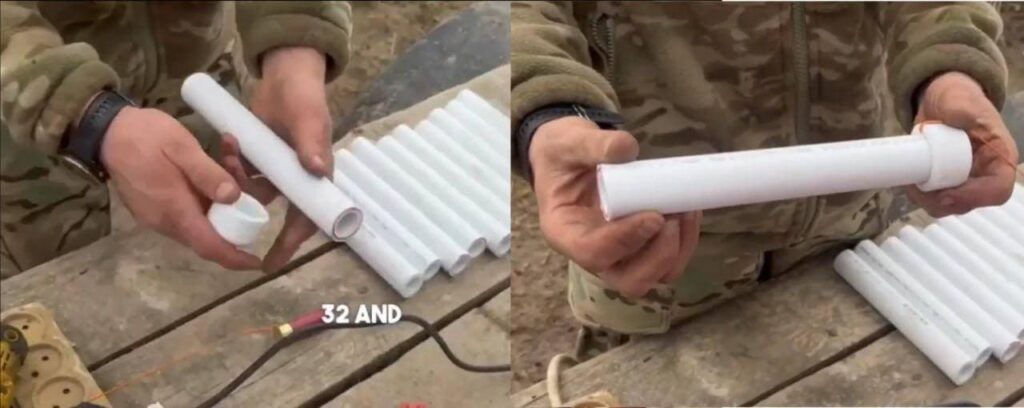A Russian soldier demonstrates a simple drone shotgun firing tube
Drone technology has advanced rapidly during the conflict in Ukraine. Just a couple of months ago we reported on a Ukrainian project mounting a shotgun on a drone with an ingenious method to cancel recoil. Now the Russians are fielding an alternative drone shotgun mount which looks even simpler and more efficient. More significantly, the ease of construction means the new design is likely to spread fast.
Arming Drones
Shotguns are handy for shooting down other drones, but the recoil is a problem. The weapons are notorious for their heavy kick, unavoidable when throwing out a large mass of lead at high speed. Such recoil is difficult to manage on a fragile. lightweight drone.
The Ukrainian approach negated recoil by putting two shotgun cartridges back-to-back and firing them together, for a zero net recoil. The Russian version is even simpler: the shotgun cartridge is fired from a tube which breaks away from the drone on firing.
OSINT analyst Roy posted about the new development on Twitter/X, noting that that the 12-guage cartridges are fired from fiberglass-reinforced polypropylene tubes attached to the drone with plastic clips. As Roy notes, the clips are not in fact 3D printed as first thought: they are household hardware supplies, normally used for securing water pipes. This is real low-tech stuff.
The ammunition is a standard shotgun cartridge, modified by drilling a small hole in it, removing some of the powder and fitting an electric match so the round can be fired by an electrical impulse rather than a mechanical one.
As with many drone drop mechanisms, the device is triggered simply by turning on the drone’s LED signal light. This means the shotgun can be easily attached to any existing drone, in particular the ubiquitous DJI Mavics favored by Russian troops.
“I believe the Russian ‘breakaway’ shotgun attachment is a better solution for mounting on a Mavic than Ukrainian recoilless designs,” Roy told me. “It’s the simplest and lightest solution for Mavics especially, which don’t have much extra payload capacity.”
Roy notes that the firing tube may be joined to the drone with a tether to catch it when it breaks away, so the tube is not expended each time.
According to the Russians, different versions carry 12-guage or 16-guage cartridges and have an effective range against drones of 20 meters/22 yards.
Weapons For Interceptors
Many videos show Ukrainian shotgun drones shooting down Russian Mavics and the Russians now seem to be doing the same. This video, originally posted by Russian drone company KB ATL was captioned “A new way to fight birds. Works mainly on DJI Mavic and hexes [hexacopter drones with six rotors].”
The video shows several engagements in which a drone with two shotgun barrels shoots down quadcopters, mainly carrying bombs. In most instances the shotgun blast damages the drone and the target plunges to the ground, in one (at 0:29 in the video) the drone payload detonates spectacularly.
“Mavics with their thin, brittle plastic are not as tough as carbon-fiber-framed FPVs,” says Roy. “Standard, widely available 12-guage shotgun cartridges are certainly enough at close range for their destruction.”
Birdshot may not be enough to take down bigger drones, in particular the Ukrainian ‘Baba Yaga’ multicopter heavy bombers, some of which are reportedly armored. The same applies to other aerial targets.
“Recoilless designs with much heavier custom loads are needed for mounting on FPV interceptors hunting big, fast-moving fixed-wing reconnaissance UAVs, or elusive enemy FPVs,” says Roy.
These are the loads used by Canadian drone interceptor pilot Butcher who takes down Russian scout drones and Lancets at high altitude.
KB ATL do not market a shotgun attachment, and the actual source of the video is unknown. Snowy scenes indicate that some of the videos are not recent. But similar images of Russians assembling drone shotgun units indicates they are already in widespread use.
Dogfighting Drones
As many observers have already noted, drone evolution in Ukraine has followed the same lines as aerial warfare in WWI, when simple biplanes were first used for scouting, then adapted for bombing, then for shooting down other aircraft and finally for fighting each other.
In the next stage we are increasingly like to see quadcopter dogfights as armed drones encounter other armed drones. Bombers will need fighter escorts, or they might start to carry defensive armament of their own. FPVs, with their greater payload capacity, can carry many more shotgun tubes tubes, and a ‘fighter bomber’ with a mix of grenades and shotguns is clearly possible. The shotguns might also be effective against ground targets at short range, even throug ‘anti-drone’ netting..
A similar Russian drone shotgun attachment
Software is likely to be the most important factor in future drone-on-drone actions, but it will need cheap readily-available hardware. And, as the Russian videos show, the next stages of evolution are unlikely to come from the big aerospace companies or even drone makers. Field workshops and garage tinkerers can experiment with the technology and maybe improve on it further.
“Anyone with a little skill and a shotgun cartridge can turn their retail drone into a weapon,” says Roy.
Read the full article here
